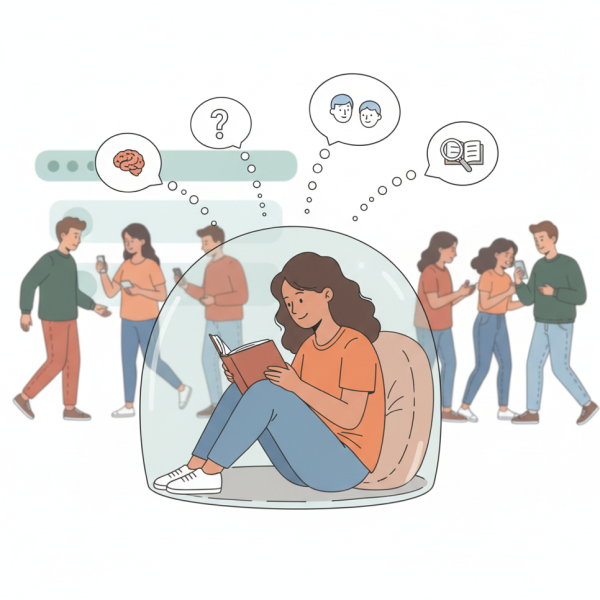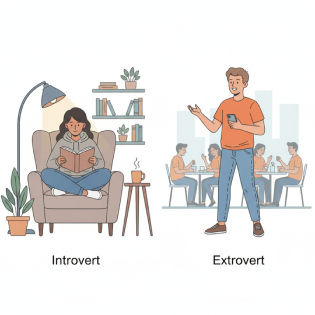
Take the Introvert Quiz to Explore Your Personality
Curiosity often centers on the inquiry, is introvert a personality, which leads many people to wonder whether the label is destiny or simply a shorthand for observable behavior. Clarity improves when we distinguish trait from type and unpack the introvert extrovert meaning in terms of arousal thresholds, preferred environments, and recovery cycles. Rather than boxes, think of these as dials that can be tuned across contexts and over the lifespan.
- Energy sourceDo you recharge in solitude, with select company, or in lively groups?
- Stimulation levelWhat amount of novelty and noise keeps you in the “focus zone”?
- Recovery cadenceHow quickly do you return to baseline after intense social activity?
- Context shiftWhich roles or spaces nudge you to stretch, and which invite retreat?
Introvert Vs Extrovert Differences
Researchers caution that debates framed as introvert vs extrovert can overshadow situational effects, cultural norms, and developmental experiences. Practical routines highlight the difference between introvert and extrovert tendencies in how energy is lost or gained during group events, open offices, or back-to-back calls.

Benefits of Each Style: Introvert Vs Extrovert
Hiring managers gain value when they map projects to diverse introvert personality types that favor deep analysis, careful synthesis, and sustained attention. Team design excels when leaders embrace the continuum of introvert extrovert ambivert patterns, allowing flexible roles that rotate between spotlight and support. The payoff is visible in better risk management, sharper creativity, and steadier execution under pressure.

Inclusive Collaboration for Different Energy Types
Cross-functional efforts benefit when norms explicitly balance introvert extrovert participation to ensure ideas are captured before momentum pushes past quieter contributions. Meeting formats improve when the common tug-of-war, extrovert vs introvert, yields to turn-taking, structured rounds, and written inputs that anchor clarity. The following snapshot summarizes environment tweaks that let different energy styles do their best work.
| Collaboration Moment | Quiet-Friendly Design | Talk-Friendly Design | Balanced Tip |
|---|---|---|---|
| Brainstorm | Circulate prompts 24 hours ahead | Run rapid-fire idea rounds | Combine pre-reads with short live bursts |
| Decision Meeting | Collect written positions first | Facilitate structured debate | Vote after silent review of options |
| Project Kickoff | Document goals and constraints | Host energizing alignment call | Record decisions and next steps in writing |
| Retrospective | Offer private feedback forms | Invite storytelling highlights | Synthesize themes before action items |
When organizations codify these habits, they reduce misattributions like “lack of enthusiasm” or “dominates the room” and replace them with shared protocols. This makes performance more predictable and culture more humane, which, in turn, enhances retention and innovation.
- 1Publish norms for turn-taking and time-boxing.
- 2Track participation via written and verbal channels.
- 3Rotate facilitation to diversify voices and styles.
- 4Document agreements and provide quiet review time.
Quick Introvert Quiz to Explore Energy Patterns
Students sometimes use an introvert extrovert quiz as a quick mirror that sparks conversation rather than a verdict. For career planning, a validated introvert extrovert test can reveal preferences for focus, collaboration, and recovery without confining identity to a single box. If curiosity continues, a lightweight introvert test offers language for boundaries, overstimulation triggers, and the rituals that reset attention.

- 1Sample different work rhythms and document outcomes.
- 2Compare solo focus days with collaboration-heavy sprints.
- 3Ask peers which environments showcase your best contributions.
- 4Adjust one variable at a time and measure the effect.
Introvert Check-Ins for Busy Days
Personal check-ins that start with reflective prompts like am i an introvert encourage honest energy budgeting before obligations stack up. Some readers wonder, what is extroverted introvert, when they notice a comfort with people coupled with a strong need for solitary recharge after social peaks. Naming these nuances turns confusion into strategy by matching tasks and environments to shifting bandwidth.

Frequently Asked Questions
- Are these tendencies fixed, or can they change?
Core preferences tend to be stable, but expression shifts with experience, skills, and environments. Coaching, role design, and recovery habits can expand your range without erasing your baseline. Treat identity as a compass, not a cage.
- How do teams support both quiet workers and talk-driven contributors?
Use dual channels, pre-reads and live sessions, so ideas emerge in multiple formats. Rotate facilitation, capture input in writing, and time-box discussions to create equitable airtime. Document decisions, then invite asynchronous commentary to refine them.
- Are there recognized subcategories within introversion?
Scholars and practitioners describe distinct flavors that differ in motivation, sensitivity, and engagement style. In popular frameworks, people often encounter the 4 types of introverts concept, which organizes patterns to make coaching more precise. Remember that these maps are tools for reflection, not rigid boxes.
- What should I know before trying online assessments?
Treat results as prompts for journaling, conversations, and experiments rather than absolute answers. Many people start with a brief tool like an introvert quiz and then triangulate with lived data over several weeks. The best outcomes come from combining insights with real-world trials.
- What signs suggest my social balance is healthy?
Look for steady attention, reliable sleep, and consistent follow-through across different types of days. If you can sustain curiosity without tipping into exhaustion or restlessness, your routines are probably well tuned. Adjust cadence when productivity starts to feel brittle or chaotic.
The Latest News
Please Note
This website (introvert-quiz.com) is not an official representative, creator or developer of this application, game, or product. All the copyrighted materials belong to their respective owners. All the content on this website is used for educational and informative purposes only.



